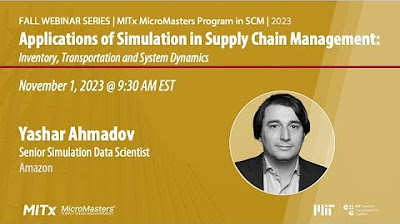Leveraging supply chain optimization and visibility to achieve carbon reduction targets
Summary
TLDR在麻省理工学院(MIT)的供应链管理(SCM)MicroMasters课程的网络研讨会中,Laura Allegue和Kellen Betts与MIT交通与物流中心的研究科学家及讲师、可持续供应链实验室主任Dr. Josue Velazquez进行了深入对话。Dr. Velazquez分享了关于可持续供应链管理(SSCM)的洞见,特别是优化和可见性技术在推动可持续决策中的作用。他通过实际研究项目案例,展示了如何通过延长交货时间来提高运输效率并减少碳排放,同时探讨了在实施可持续供应链实践中遇到的挑战。此外,Dr. Velazquez还讨论了供应链各参与方之间数据共享的重要性,包括信任、安全和合作的考量。他鼓励MicroMasters学生利用优化和机器学习技术来解决供应链中的可持续性问题,并提供了关于如何开始这一旅程的建议。
Takeaways
- 🎓 麻省理工学院(MIT)的可持续供应链管理(SCM)项目强调了优化模型和可持续实践的重要性。
- 🌿 Dr. Josue Velazquez 讨论了可持续供应链管理中优化和可见性的作用,以及如何利用这些技术实现可持续性策略。
- 📈 通过实际研究项目展示了如何通过优化和技术创新来应对实施可持续供应链实践时面临的挑战。
- 🚚 快速配送服务的增长导致了碳足迹的增加,而通过优化配送时间和路线可以减少这种影响。
- 💡 通过提供环境影响信息给消费者,可以激励他们选择更环保的配送选项,从而减少碳排放。
- 📊 通过数据分析和模拟,研究者们能够准确估计通过延长配送时间窗口而节省的二氧化碳排放量。
- 🔍 供应链的可见性不仅涉及消费者,还包括与供应链合作伙伴共享信息,这需要建立信任和合作。
- 🤝 合作和沟通是实现供应链可持续性的关键,包括与供应商和客户共享数据和减少环境影响。
- 📝 讨论了在优化模型中包括二氧化碳排放量作为决策变量的可能性,以及如何通过算法处理这些变量带来的复杂性。
- 📈 Dr. Velazquez 建议对刚开始接触这些概念的 MicroMasters 学习者来说,应该从学习优化、技术和可见性开始他们的旅程。
- ♻️ 强调了在经济激励和环境激励之间找到平衡的重要性,以及如何通过这些激励措施影响消费者的选择。
Q & A
为什么MIT可持续供应链实验室的主任Josue Velazquez博士在这次网络研讨会上?
-Josue Velazquez博士参与了这次网络研讨会,分享了他在可持续供应链管理、优化和科技方面的专业知识。他最近在edX上推出了关于可持续供应链的大规模在线课程,并且作为MIT可持续供应链实验室的主任,他参与了多个与供应链可持续性相关的研究项目。
在网络研讨会中提到的供应链管理中,为什么环境可持续性是一个热点话题?
-环境可持续性成为热点话题是因为越来越多的公司和客户开始关注其运营对环境的影响,并设定了明确的碳减排目标。供应链管理涵盖了几乎所有商业流程,这些流程中的许多活动,如运输和材料提取,对环境有着直接的影响。
为什么在实现供应链可持续性时,优化和可见性是两个主要的工具和技术?
-优化和可见性是实现供应链可持续性的关键工具,因为它们可以帮助公司在满足客户需求的同时,最小化成本并减少环境影响。优化可以提高效率,而可见性则有助于更好地规划和决策,从而实现可持续性战略。
在网络研讨会中,Josue提到了哪些与供应链可持续性相关的实际研究项目?
-Josue提到了几个实际的研究项目,包括与墨西哥零售商Coppel合作的项目,该项目通过延长配送时间窗口来提高配送的整合性,从而减少了CO2排放。他还提到了使用优化模型来改善配送网络设计的研究。
在网络研讨会中提到的“Green Button”项目是什么,它如何帮助实现可持续性?
-“Green Button”项目是一个实验,它通过向消费者提供关于配送选项的环境影响信息,鼓励消费者选择更环保的配送方式。实验表明,超过50%的消费者愿意为了环保而延迟收货,这表明通过提高可见性和透明度,可以有效地促进消费者参与供应链的可持续性策略。
在讨论供应链可持续性时,为什么信任和合作的考虑如此重要?
-信任和合作在供应链可持续性中至关重要,因为它们是数据共享和信息透明度的基础。公司可能不愿意共享可能影响其竞争力的信息,如排放数据。因此,建立信任和明确的合作规则对于实现供应链各方的透明度和数据共享至关重要。
在网络研讨会中,Josue提到了哪些技术或方法可以用来优化供应链网络设计?
-Josue提到了多种技术,包括使用启发式算法、遗传算法、元启发式算法以及大型优化软件(如Gurobi、CPLEX、Google OR)来处理更复杂的优化问题。他还提到了多目标优化和机器学习技术在解决这些问题中的潜在应用。
为什么MicroMasters学习者应该学习优化和使用技术来帮助实现更可持续的供应链?
-MicroMasters学习者应该学习优化和使用技术,因为这些技能对于理解和改进供应链管理至关重要。这些工具和技术可以帮助他们在未来的职业中解决实际问题,提高供应链的效率和可持续性,这对于任何从事供应链工作的专业人士来说都是关键能力。
在网络研讨会中,Josue是否提到了关于供应链可持续性的职业机会?
-是的,Josue提到了供应链可持续性领域中存在多种职业机会。他提到了数据科学、物流、消费者理解以及运营研究等领域的职业,并鼓励学习者通过实践和参与相关课程来发展他们的理解。
在网络研讨会中,Josue如何描述在电子商务和快速配送环境下,供应链的挑战和机遇?
-Josue描述了电子商务和快速配送环境下,供应链面临的挑战,包括增加的碳足迹和对规划时间的压缩。同时,他也指出了机遇,比如通过提供更多的配送时间窗口,可以改善配送的整合性,减少能源消耗和CO2排放。
在网络研讨会中,Josue是否讨论了不同运输选项的价格敏感性问题?
-是的,Josue讨论了不同运输选项的价格敏感性问题。他提到了他们进行的一项研究,其中测试了消费者对于经济激励和环境激励的敏感性。研究发现,如果提供经济激励或环境激励,大多数消费者愿意等待更长时间的配送。
Outlines

This section is available to paid users only. Please upgrade to access this part.
Upgrade NowMindmap

This section is available to paid users only. Please upgrade to access this part.
Upgrade NowKeywords

This section is available to paid users only. Please upgrade to access this part.
Upgrade NowHighlights

This section is available to paid users only. Please upgrade to access this part.
Upgrade NowTranscripts

This section is available to paid users only. Please upgrade to access this part.
Upgrade NowBrowse More Related Video

AI-Driven Supply Chains: 3 Cases | MIT SCALE Webinar | Spanish

From Automated to Autonomous Supply Chains

Lean, Green, and Digital: Leveraging SCM Tools to Balance Complex Tradeoffs

Supply Chain Management as a Partner with Finance

MIT Supply Chain Management Master's Program Information Session with Student Panel

Applications of Simulation in Supply Chain Management
5.0 / 5 (0 votes)
